Summary
In this project we develop and apply electrochemical and surface science principles to the study of advanced wet chemical deposition processes and emerging energy and chemical conversion technologies. Our effort is focused on gaining mechanistic understanding of electrochemical processes from atomistic and mesoscale dimensions to macro electrodes and reactor scale engineering.
The project has four thrusts.
- Operando measurements to investigate and characterize electrochemical interfaces and reactivity.
- Computational models of electrochemical processes ranging from atomistic models of interface structure and reactivity to continuum level simulations of thin film growth.
- Surfactant mediated electrochemical deposition to control the morphology and microstructure of electrodeposited materials in complex 3-D structures including microelectronic interconnects, diffraction gratings, and microelectromechanical systems.
- Synthesis and measurements of electrocatalytic materials and processes central to the development of a hydrogen economy, CO2 remediation and, more generally, the electrification of sustainable chemical processes.
Description
Operando Measurements
Measurements of the structure and dynamics of metal-electrolyte interfaces are essential for understanding mechanisms of electrocatalysis and electrodeposition that are key to optimization of materials processing and utilization in wet chemical environments. Our measurement capabilities include electrochemical scanning tunneling microscopy (ECSTM), scanning electrochemical microscopy (SECM), surface enhanced infrared spectroscopy (SEIRAS), shell isolated Raman spectroscopy (SHINERS), surface and thin film growth stress, electrochemical quartz gravimetry (EQCM), and electrochemical mass spectrometry (EC-MS).
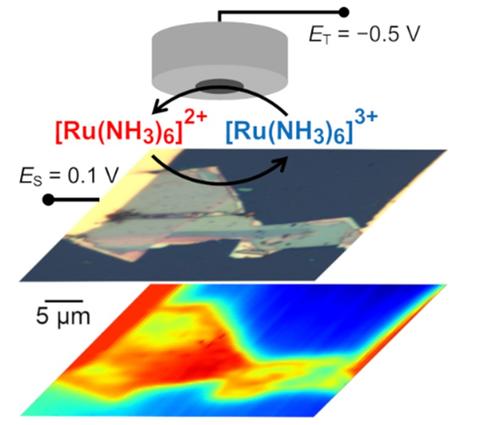
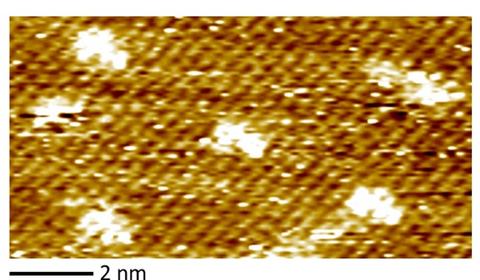
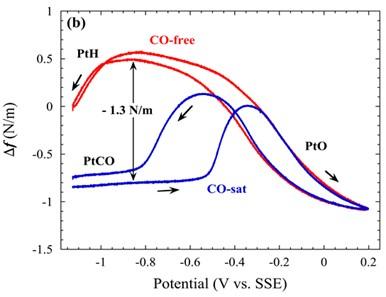
Computational Models
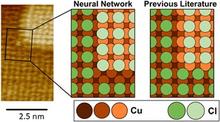
The double layer plays a central role in the reactivity of charged liquid-solid interfaces. From adsorption to charge transfer reactions, atomistic modeling is computationally difficult, requiring description of the electronic structure and dynamics of the electrolyte. A variety of different methods and models are being explored, ranging from density functional theory (DFT) to machine learning (ML). Models of varying complexity are used to predict interfacial properties and how these change in the presence of adsorbates. Anion adsorption is of particular interest as Cl- is a key additive in industrial Cu electrodeposition processes. Recent DFT and ML studies of surfaces vicinal to Cu(100) indicate that Cl- adsorbs at the three-fold hollow sites on the upper step edge accounting for the structure and strong faceting observed in ECSTM experiments.
Another topic of interest is CO adsorption where binding to Pt group metals and alloys poisons electrocatalytic reactions. Surface stress measurements combined with DFT reveal that CO adsorption on Pt significantly alters the capacitance and leads to compressive stress due to charge redistribution within the first two metal layers.
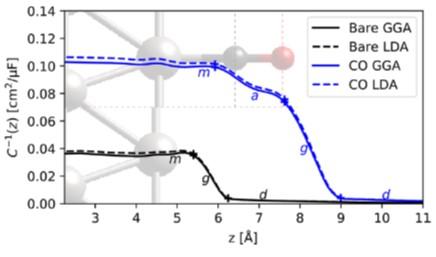
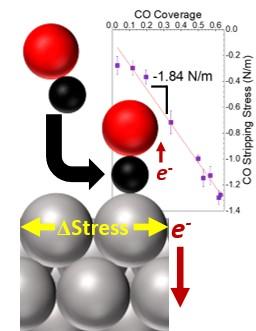
Surfactant Mediated Growth
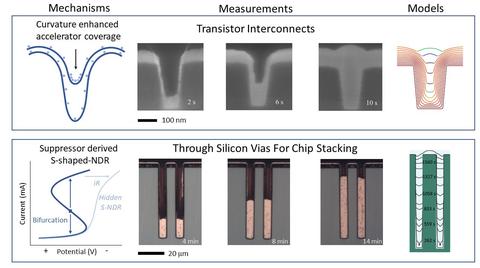
Surfactants are widely used to control the morphology, microstructure, and properties of electrodeposited materials. How additives impact the rate of metal deposition and microstructure, particularly on non-planar surfaces, is central to superconformal and bottom-up deposition processes that are widely used for micro and nanoscale fabrication. Mechanistic understanding coupled with electroanalytical, surface science and metallurgical measurements provides the physical basis and parameterization for robust computational models of feature filling. NIST continues to develop the broadly applicable curvature enhanced accelerator mechanism (CEAC) that accounts for Cu superfilling processes used in the fabrication of on-chip interconnects.
For larger length scale features such as Cu through silicon vias (TSV) non-linear negative differential resistance behavior (S-NDR) is a key characteristic associated with suppressor adsorbate breakdown that enables extreme bottom-up filling.
Coupling between the electrical and compositional gradients within the electrochemical deposition system, and the circuitry that controls it, yields spatially and temporally localized deposition during filling of patterned features. Optimization of these effects enables defect-free filling of complex patterns having variable dimensions.
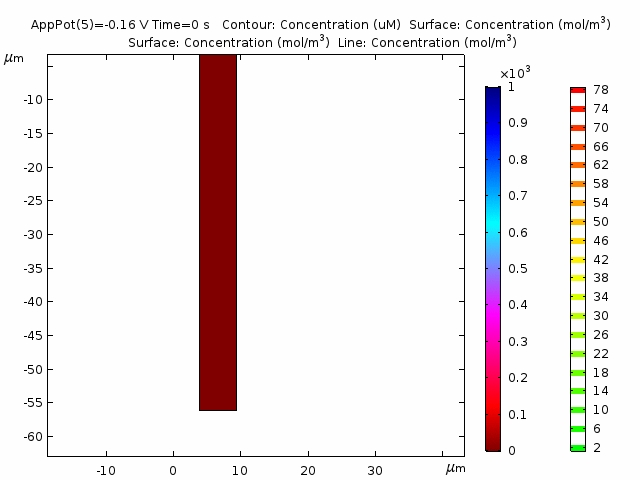
Credit: Trevor Braun
Effort to further develop the molecular level understanding of such critical systems and their impacts on morphological and microstructural evolution are underway.
Extension of superfilling processes to advanced packaging and alternative computational schemes, as well as new materials and devices, continues including efforts in conjunction with, and otherwise assisting, industrial partners. These include a new modality of bottom-up trench and via filling with Au stimulated by Bi3+ ions that has been discovered and applied to the fabrication of phase shift gratings for X-ray tomography including collaboration and technology transfer for imaging applications.
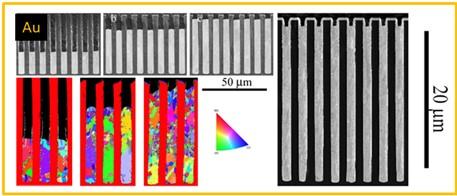
Electrocatalysis
Electrochemistry is a central discipline in the world-wide shift towards electrification of transportation, the chemical process industry, and the energy sector more broadly. Improved performance and durability of electrocatalyst are fundamental to an economically viable H2 economy. Several “wet” analogs of atomic layer deposition (ALD) reactions have been developed that enable the thrifty use of expensive Pt group metals. Of particular interest is the discovery of H-induced self-terminated electrodeposition of Pt and Ir. Coupling these reactions with pulsed potential deposition has been used to grow ultrathin Pt and Ir layers on different substrates that facilitate the study of bimetallic catalysis.
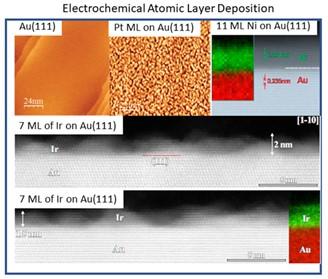
The pressing need to mitigate rising atmospheric CO2 levels and establish a more sustainable industrial carbon cycle motivate the exploration of catalysis of complex multistep reactions such as CO2 reduction. Silver is among the best catalysts for CO2 reduction to CO but a viable process requires efficient, high throughput reactors. Innovative gas diffusion electrode (GDE) designs with defined mass and charge transport are needed to optimize the competing requirements of catalytic performance, selectivity, durability, and resistance to flooding. A GDE platform based on Ag nanowires supported on porous fluorinated polymers demonstrate selective generation of CO at yields greater than 90% and commercially relevant current densities approaching 100 mA/cm2.
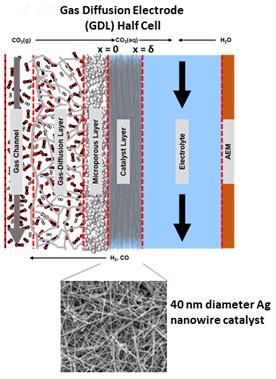
Looking beyond CO generation, Cu is the only elemental metal capable of producing hydrocarbons via CO2 reduction. Studies are underway to understand these unique processes using a combination of EC-MS and SHINERS. Formation of a surface hydride layer on Cu (111) and its decomposition by H recombination explains long unresolved voltametric features and opens a new chapter in the investigation of the special role of Cu in catalytic CO2 hydrogenation reactions and, more generally, the electrification of more sustainable chemical processes.
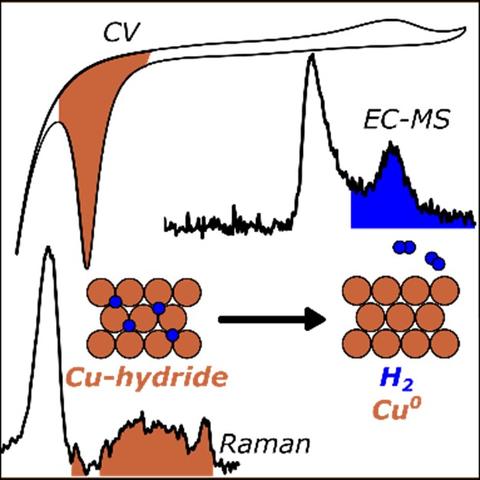
National Research Council Postdoctoral Fellowship – Sponsors U.S. citizens to explore the frontiers of science related to NIST mission. Please contact us if you're interested in this wonderful program. New topics are always welcome in addition to the following existing opportunities.
Electrochemical Surface Science of Metal-Electrolyte Interfaces: Theory and Experiment
Proximal Probe Studies of the Electrode-Electrolyte Interface

